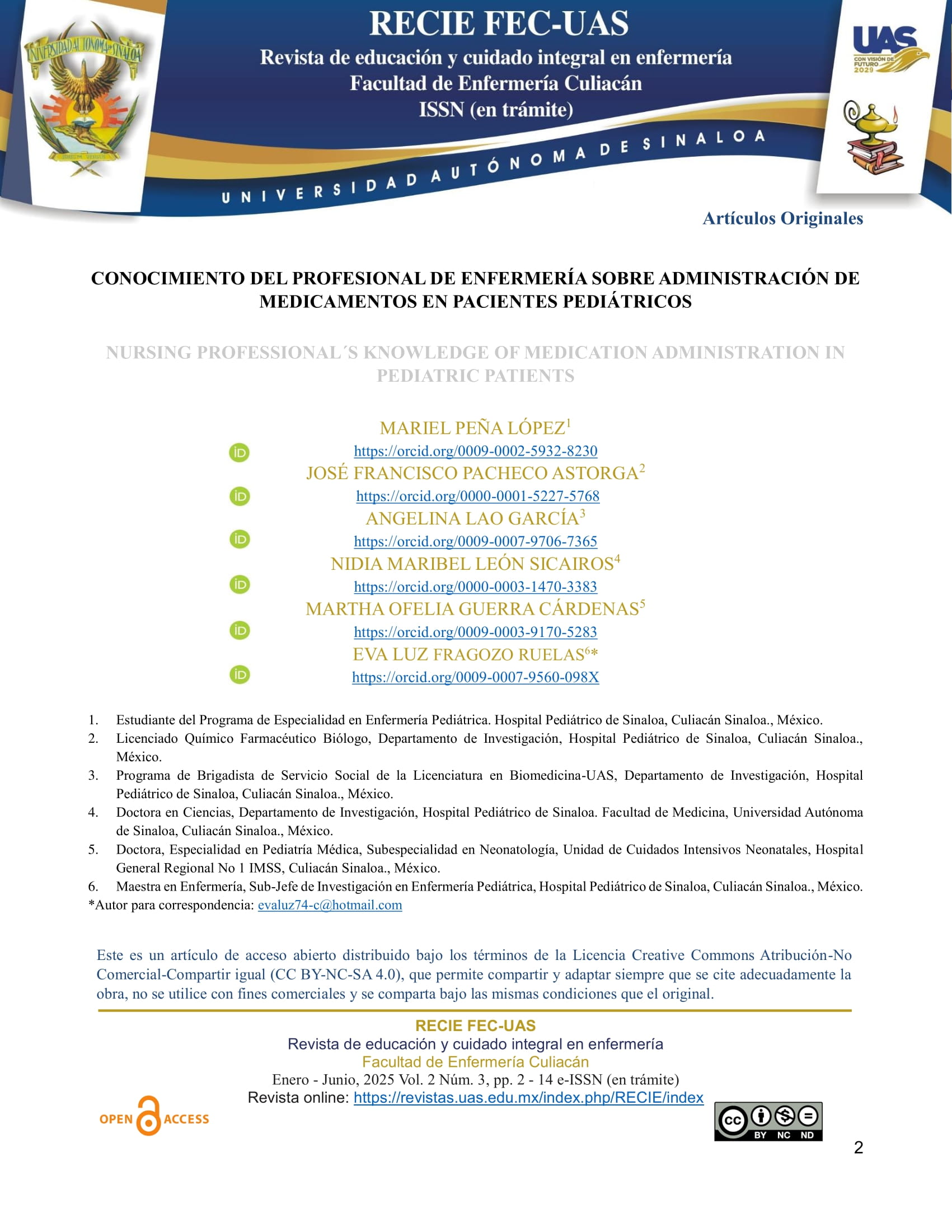Nursing professional´s knowledge of medication administration in pediatric patients
Keywords:
Knowledge, Nursing, Medication administrationAbstract
Introduction: The nursing profession plays a substantial role, since they are responsible for the administration of medications, which must comply with the best quality and safety standards in patient care. Objective: To identify the level of knowledge that nursing professionals have in the administration of medications in pediatric patients. Methodology: A quantitative, descriptive, cross-sectional research was carried out on the personnel nursing professionals belonging to the Pediatric Emergency Service, in charge of the administration of medications during the period from November 2022 to December 2023. The information was collected through the Patient Safety Instrument in the Administration of Medications in Pediatrics (SPAMP-vE). Results: A total of 34 nursing professionals participated, where 79.4% were female, with an average age of 35 years, with the 30 to 39 age group predominating with 64.7%. The average achieved in the domains of compliance in the administration of medications was 87.67%. Regarding the level of knowledge of nursing professionals, the vast majority obtained 56% as very adequate, 32% as adequate and only 12% as deficient in the administration of medications in pediatrics. According to our population, a Cronbach's Alpha of .801 was obtained, demonstrating a high internal consistency of the instrument. Conclusions: It is essential to contribute to and strengthen a culture of quality and safety for pediatric patients, which is why ongoing training is recommended to increase their knowledge.
Downloads
References
Builes Sierra, M. A. & Rojas Espitia, L. A. (2021). La administración de medicamentos por el profesional de enfermería en hospitalización, en una institución de segundo nivel de complejidad. [Tesis de maestría, Universidad de Ciencias Aplicadas y Ambientales]. Udca. 1-96.
https://repository.udca.edu.co/entities/publication/7866a7ca-dae0-4c8d-9451-20e4d9769f9b
Carrasco Fernández, J. A., Diaz Manchay, R. J., Rodríguez Cruz, L. D., Tejada Muñoz, S. & Sánchez Chero, M. J. (2020). Sistema de seguridad en la administración de fármacos en servicios pediátricos hospitalarios. Revista Cubana de Pediatría. 92(3), 1-14. http://scielo.sld.cu/pdf/ped/v92n3/1561-3119-ped-92-03-e961.pdf
Díaz Bracamonte, D., Díaz Salas, F., García Suarez, R. & de Pérez Zambrano, N. (2023). Desempeño del personal de enfermería durante la administración de tratamiento. Arte y Cuidado. 16(1), 29-34. DOI: https://doi.org/10.5281/zenodo.7579193
Guerrero-Márquez, G., Martínez-Serrano, A., Míguez-Navarro, C., López-Mirón, J. A. & Espartosa-Larrayad, M. (2016). Conocimiento de las enfermeras de las dosis de medicamentos en urgencias de pediatría. Enfermería Clínica, 26(4), 213-219. DOI: https://doi.org/https://doi.org/10.1016/j.enfcli.2016.04.009
IMSS-BIENESTAR. (2024). Servicios Públicos de Salud. Guía para la Implementación de las Acciones Esenciales para la Seguridad del Paciente. Unidad de Atención a la Salud. 1-63. https://imssbienestar.gob.mx/assets/docs/coord_educacion/GUIA_IMPLEMENTACION_AESP_NOVIEMBRE%20.pdf
Manzini, J. L. (2000). Declaración de Helsinki: principios éticos para la investigación médica sobre sujetos humanos. Acta bioehtica 6(2), 321-334. DOI:
http://dx.doi.org/10.4067/S1726-569X2000000200010
Orellana-Centeno, J. E., Guerrero Sotelo, R. N. & Morales-Castillo, V. (2020). La seguridad en el paciente odontológico de acuerdo con la CONAMED. Revista ADM Órgano Oficial de la Asociación Dental Mexicana, 77(2), 96-99. DOI:
https://dx.doi.org/10.35366/93102
Pérez Núñez, B. K. (2023). Estudiantes universitarios de Enfermería, su conocimiento en farmacología y aplicación clínica. Revista Latinoamericana de Investigación Educativa. 2(4), 6-12. https://unimeso.edu.mx/ojs/index.php/ReLIE/article/view/70
Ponce Gómez, G., López Cruz, R. & Carmona Mejía, B. (2016). Competencias profesionales de enfermería en la ministración de medicamentos de alto riesgo en pediatría. Fundación Dialnet. 21(3), 116-121.
https://dialnet.unirioja.es/servlet/articulo?codigo=7302302
Puma-Quito, R. S., Mesa-Cano, I. C., Ramírez-Coronel, A. A. & Pacurucu-Avila, N. J. (2021). Efectividad de intervenciones de enfermería basada en protocolos de administración segura de medicamentos por vía venosa: revisión sistemática. Sociedad Venezolana de farmacología clínica y terapéutica. 40(3). https://www.redalyc.org/journal/559/55969712009/html/
Romero Gutiérrez, D. L., Almiray Soto, A. L. & Ensaldo Carrasco, E. (2020). Intervenciones en la administración de medicamentos de alto riesgo. Revista CONAMED, 25(2), 95-97. DOI: https://dx.doi.org/10.35366/94393
Rosas, G., Rivera, C. y Hernández, T. (2018). Nivel de conocimiento teórico del personal de enfermería en administración de medicamentos de alto riesgo. Paraninfo Digital; 28. https://www.index-f.com/para/n28/e128.php
Saldarriaga Sandoval, L. J., Teixeira Lima, F. E., de Almeida, P. C., Pinheiro Barbosa, L., Souza Gurge, S. & Pascoal, L. M. (2021). Confiabilidad del instrumento Seguridad del Paciente en Administración de Medicamentos en Pediatría- Versión española. Enfermería Global, 20(3), 330-361. DOI: https://doi.org/10.6018/eglobal.442261
Secretaría de Salud [SSA]. (2014). Reglamento de la Ley General de Salud en Materia de Investigación. 1-31.
https://www.diputados.gob.mx/LeyesBiblio/regley/Reg_LGS_MIS.pdf
Totoy Cabezas, L. J. (2023). Conocimiento enfermero/a sobre medicamentos de alto riesgo aplicado a pacientes en cuidados intensivos pediátricos. [Tesis de maestría, Facultad de Ciencias Médicas]. Universidad Uniandes. 1-24.

Downloads
Published
Issue
Section
Categories
License
Copyright (c) 2025 RECIE FEC-UAS Revista de educación y cuidado integral en enfermería Facultad Enfermería Culiacán

This work is licensed under a Creative Commons Attribution-NoDerivatives 4.0 International License.

